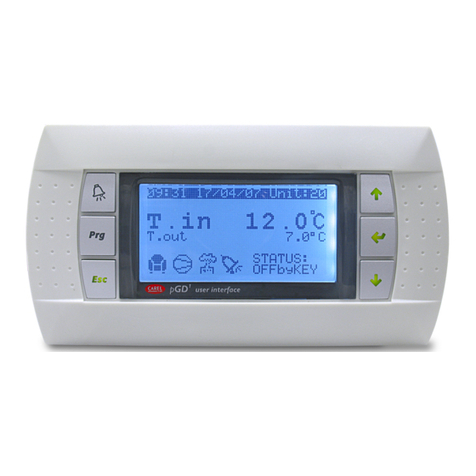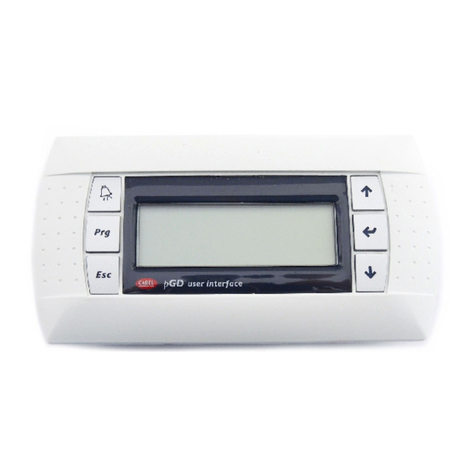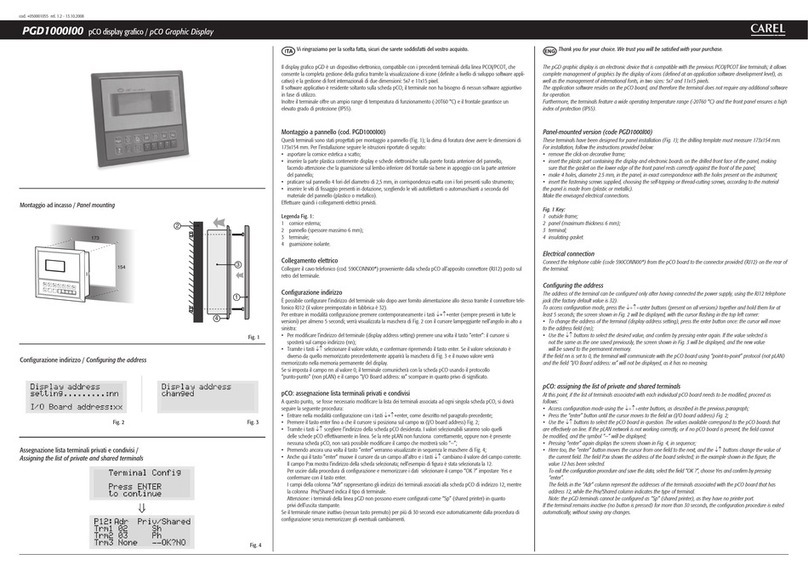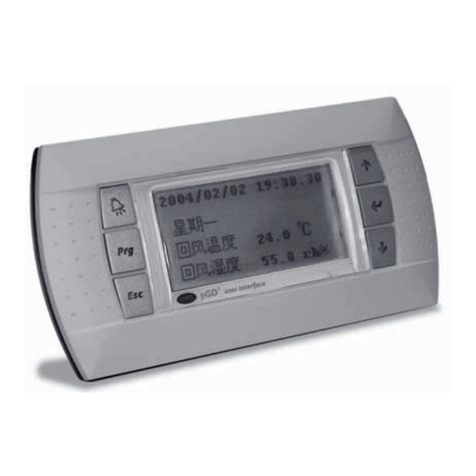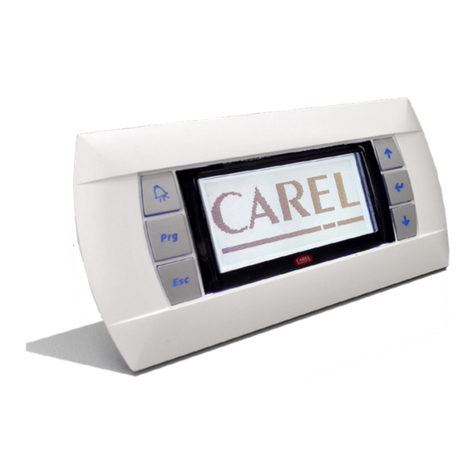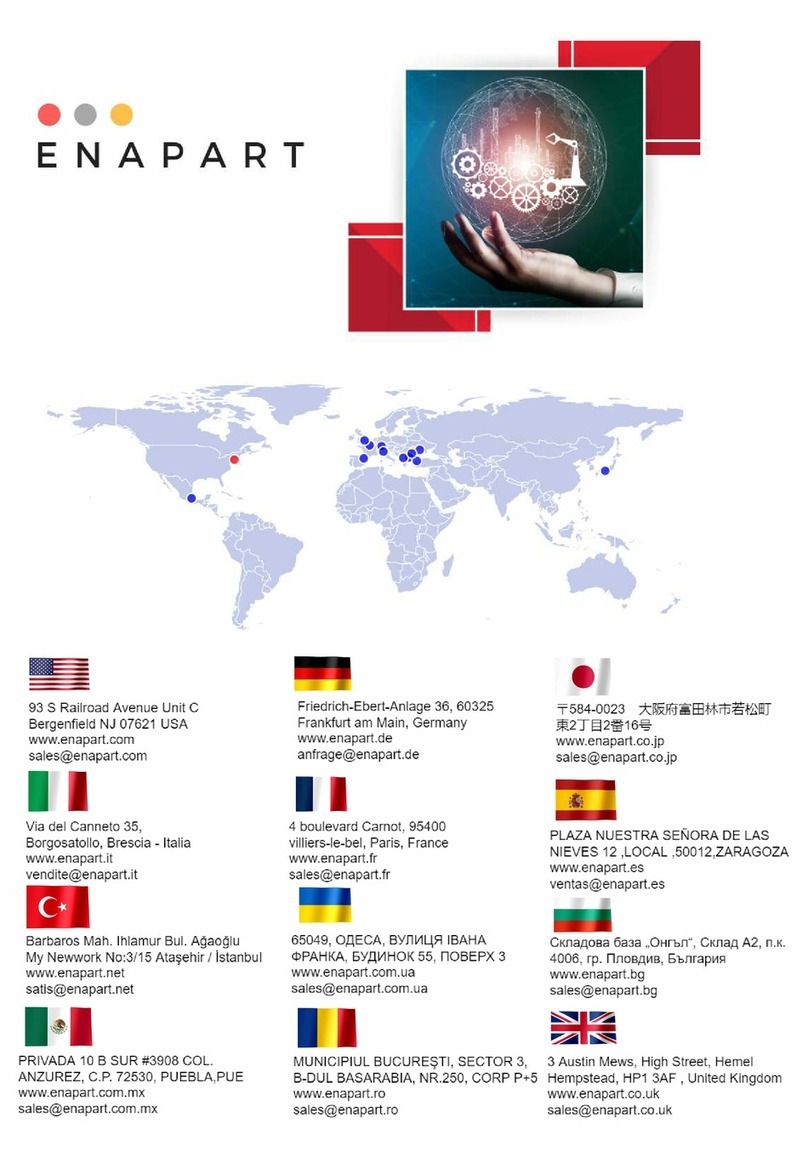
PGD0000T00 - pCO display grafico / pCO graphic display
+050001180 - rel. 1.1 - 13.10.2008
Il display grafico pGD è un dispositivo elettronico, compatibile con i precedenti terminali della linea PCOI/
PCOT, che consente la completa gestione della grafica tramite la visualizzazione di icone (definite a livello di
sviluppo software applicativo) e la gestione di font internazionali di due dimensioni: 5x7 e 11x15 pixel.
Il software applicativo è residente soltanto sulla scheda pCO, il terminale non ha bisogno di nessun software
aggiuntivo in fase di utilizzo.
Inoltre il terminale offre un ampio range di temperatura di funzionamento (-20T60 °C) e il frontale garantisce un
elevato grado di protezione (IP55).
Montaggio dei terminali
Questo tipo di terminale è stato disegnato per il montaggio a pannello e a parete (rispettivamente Fig. 1a e 1b).
La dima di foratura, nel caso di montaggio a pannello, deve avere le dimensioni 167x108 mm.
Per l’installazione seguire le istruzioni seguenti:
svitare le due viti poste sul coperchio posteriore del terminale e sfilare il coperchio;•
appoggiare il frontale sulla parte anteriore del pannello;•
Inserire il coperchio dalla parte posteriore facendo coincidere i due fori con i due prigionieri posizionati nel•
coperchio;
frontale;•
riavvitare le viti.•
Lo spessore massimo del pannello è di 6 mm. Effettuare quindi i previsti collegamenti elettrici.
Collegamento elettrico
Collegare il cavo telefonico (cod. S90CONN00*) proveniente dalla scheda pCO all’apposito connettore (RJ12)
posto sul retro del terminale.
Configurazione indirizzo
È possibile configurare l’indirizzo del terminale solo dopo aver fornito alimentazione allo stesso tramite il connetto-
re telefonico RJ12 (il valore preimpostato in fabbrica è 32).
Per entrare in modalità configurazione premere contemporaneamente i tasti ↓+↑+enter (sempre presenti in tutte
le versioni) per almeno 5 secondi; verrà visualizzata la maschera di Fig. 2 con il cursore lampeggiante nell’angolo in
alto a sinistra:
Per modificare l’indirizzo del terminale (display address setting) premere una volta il tasto ”enter”: il cursore si•
sposterà sul campo indirizzo (nn);
Tramite i tasti• ↓↑ selezionare il valore voluto, e confermare ripremendo il tasto enter. Se il valore selezionato è
diverso da quello memorizzato precedentemente apparirà la maschera di Fig. 3 e il nuovo valore verrà memoriz-
zato nella memoria permanente del display.
Se si imposta il campo nn al valore 0, il terminale comunicherà con la scheda pCO usando il protocollo “punto-
punto” (non pLAN) e il campo “I/O Board address: xx” scompare in quanto privo di significato.
pCO: assegnazione lista terminali privati e condivisi
A questo punto, se fosse necessario modificare la lista dei terminali associata ad ogni singola scheda pCO, si dovrà
seguire la seguente procedura:
Entrare nella modalità configurazione con i tasti• ↓+↑+enter, come descritto nel paragrafo precedente;
Premere il tasto enter fino a che il cursore si posiziona sul campo xx (I/O board address) Fig. 2;•
Tramite i tasti• ↓↑ scegliere l’indirizzo della scheda pCO desiderata. I valori selezionabili saranno solo quelli
delle schede pCO effettivamente in linea. Se la rete pLAN non funziona correttamente, oppure non è presente
nessuna scheda pCO, non sarà possibile modificare il campo che mostrerà solo “—”;
Premendo ancora una volta il tasto ”enter” verranno visualizzate in sequenza le maschere di Fig. 4;•
Anche qui il tasto ”enter” muove il cursore da un campo all’altro e i tasti• ↓↑ cambiano il valore del campo
corrente. Il campo P:xx mostra l’indirizzo della scheda selezionata; nell’esempio di figura è stata selezionata la 12.
Per uscire dalla procedura di configurazione e memorizzare i dati selezionare il campo “OK ?” impostare
Yes e confermare con il tasto enter.
I campi della colonna “Adr” rappresentano gli indirizzi dei terminali associati alla scheda pCO di indirizzo 12,
mentre la colonna Priv/Shared indica il tipo di terminale.
Attenzione: i terminali della linea pGD non possono essere configurati come “Sp” (shared printer) in quanto
privi dell’uscita stampante.
Se il terminale rimane inattivo (nessun tasto premuto) per più di 30 secondi esce automaticamente dalla procedura
di configurazione senza memorizzare gli eventuali cambiamenti.
Segnalazione guasti
Se il terminale rivela lo stato di fuori linea della scheda pCO a cui è stato associato cancella il display e visualizza il
messaggio: I/O Board xx fault.
Mentre, se il terminale non riceve nessun segnale di rete, cancella il display e visualizza il seguente messaggio: NO
LINK.
Montaggio a pannello / Panel mounting
Configurazione indirizzo / Configuring the address
Fig. 2
3
2
1
1
84 mm
80 mm
120 mm
4
drilling template
167 x 108mm
1
5
3
2
6
=
=
Montaggio a parete / Wall mounting
coperchio posteriore;1.
pannello (spessore max. 6 mm)2.
coperchio anteriore;3.
dime di foratura: (tolleranza finestra -0,5...1 mm);4.
guarnizione per il coperchio anteriore;5.
guarnizione per il coperchio posteriore.6.
rear cover;1.
panel (max. thickness 6 mm)2.
front cover;3.
drilling template: (window tolerance -0.5-1 mm);4.
gasket for front cover;5.
gasket for rear cover.6.
staffa di fissaggio;1.
vite di fissaggio;2.
parete.3.
fastening bracket;1.
fastening screw;2.
wall.3.
Fig. 3
Fig. 1a
Fig. 1b
The pGD graphic display is an electronic device that is compatible with the previous PCOI/PCOT line
terminals; it allows complete management of graphics by the display of icons (defined at an application
software development level), as well as the management of international fonts, in two sizes: 5x7 and 11x15 pixels.
The application software resides on the pCO board, and therefore the terminal does not require any additional
software for operation.
Furthermore, the terminals feature a wide operating temperature range (-20T60 °C) and the front panel ensures
a high index of protection (IP55).
Mounting of the terminals
This type of terminal has been designed for panel and wall mounting (fig. 5 and fig. 6 respectively).
The drilling template, in the case of panel mounting, must have the dimensions of 167x108mm.
When installing stick to the following instructions:
unscrew the two screws placed on the back cover and remove the cover;•
lean the front cover against the anterior part of the panel;•
insert the cover from the back by fitting the two holes into the two studs positioned in the front cover;•
screw again the screws.•
The maximum thickness of the panel is 6mm. Then carry out the envisaged electrical connections.
Electrical connection
Connect the telephone cable (code S90CONN00*) from the pCO board to the connector provided (RJ12) on the
rear of the terminal.
Configuring the address
The address of the terminal can be configured only after having connected the power supply, using the RJ12
telephone jack (the factory default value is 32).
To access configuration mode, press the ↓+↑+enter buttons (present on all versions) together and hold them for
at least 5 seconds; the screen shown in Fig. 2 will be displayed, with the cursor flashing in the top left corner:
To change the address of the terminal (display address setting), press the enter button once: the cursor will•
move to the address field (nn);
Use the• ↓↑ buttons to select the desired value, and confirm by pressing enter again. If the value selected is
not the same as the one saved previously, the screen shown in Fig. 3 will be displayed, and the new value
will be saved to the permanent memory.
If the field nn is set to 0, the terminal will communicate with the pCO board using “point-to-point” protocol (not
pLAN) and the field “I/O Board address: xx” will not be displayed, as it has no meaning.
pCO: assigning the list of private and shared terminals
At this point, if the list of terminals associated with each individual pCO board needs to be modified, proceed as
follows:
Access configuration mode using the• ↓+↑+enter buttons, as described in the previous paragraph;
Press the “enter” button until the cursor moves to the field xx (I/O board address) Fig. 2;•
Use the• ↓↑ buttons to select the pCO board in question. The values available correspond to the pCO boards
that are effectively on line. If the pLAN network is not working correctly, or if no pCO board is present, the field
cannot be modified, and the symbol “—” will be displayed;
Pressing “enter” again displays the screens shown in Fig. 4, in sequence;•
Here too, the “enter” button moves the cursor from one field to the next, and the• ↓↑ buttons change the value
of the current field. The field P:xx shows the address of the board selected; in the example shown in the figure,
the value 12 has been selected.
To exit the configuration procedure and save the data, select the field “OK ?”, choose Yes and confirm by•
pressing “enter”.
The fields in the “Adr” column represent the addresses of the terminals associated with the pCO board that has•
address 12, while the Priv/Shared column indicates the type of terminal.
Note:the pGD terminals cannot be configured as “Sp” (shared printer), as they have no printer port.
If the terminal remains inactive (no button is pressed) for more than 30 seconds, the configuration procedure is
exited automatically, without saving any changes.
Fault signals
If the terminal detects the off-line status of the pCO board it is associated with, the display shows the message:
I/O Board xx fault.
On the other hand, if the terminal receives no signal from the network, the display shows the following message:
NO LINK.


